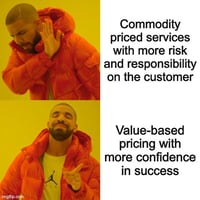As ETS founders you should already be aware of the challenges in hiring. In particular, in this...
The 5 Most Important Cliches For Designing Your Tech Services Portfolio

We regularly get accused of providing very focused, actionable content. For example, our series "Dissecting Business Units From 0 to 5M" gives a concrete walkthrough of how your business will develop and the various roles and functions you'll need to build. Our whitepaper "3 Reasons Why Growth Of Your Tech Services Startup Is Slow" breaks down the positioning of a tech startup into its essential components. Well, we can't have people thinking that. And so today, we want the most cliched business advice you receive for the day from us. The internet is very cliched, so we don't think we can hold the crown for more than a day, but today we will guide you on how to design your tech services portfolio using the following cliches:
-
Baby Steps
-
You Can't Please Everyone
-
Don't Sell Honey To Bees
-
Actions Speak Louder Than Words
-
Hit The Spot
Read on to understand how these cliches create your services portfolio.
Baby Steps
The first step to understanding your portfolio is that it is a means to nurture your relationship with your customer. Any relationship is built on trust with mutual investments from both parties. The consultant and the customer both make investments. Consultants provide value, and the customer invests attention and money into the relationship. Both the party's investments need to go hand-in-hand. As the consultant invests time to provide value to the customer, they need the customer to give them attention and money. If the consultant hasn't developed the relationship, then demands for attention and money will be ignored. Use your services portfolio to deepen this relationship and advance your customer's journey.
You Can't Please Everyone
In product development, attempting to be everything to everyone can dilute your core strengths and message. Embracing a narrower focus means:
-
Your sales message resonates more deeply with your target audience
-
Acquisition network effects through matching case studies, word of mouth, and more focused outreach efforts
-
Advanced delivery expertise for your specific customer
-
A tailor-made process matched to the needs of your customer
While narrowing your focus might seem counterintuitive, fearing missed opportunities, it's essential to understand that the increased cost of broad-based sales and diluted branding can often outweigh those potential missed chances. Embrace specialization, and you'll often find success is both deeper and more meaningful.
Don't Sell Honey To Bees
When you internalize the idea of "You can't please everyone," you end up with a defined customer for your offering. This means you can narrowly define your offering to their needs. Spend time understanding your customers and making your offer appealing to the exact problems they face. Here are some examples of how different customer personas for the same development work have distinct needs:
-
Pre-PMF Startup CEO: Desires a team for swift product development to validate ideas and secure funding. Time-to-market and quick iterations for early validation are crucial, even if it means less-than-perfect code.
-
VP of Marketing for a Large Enterprise: Brand reputation is paramount, so UX, both process and technical, needs excellent execution. Will invest significantly in services with integrated analytics and continuous project maintenance aligned with company goals.
-
VP of Engineering for a Large Enterprise: Values seamless collaboration. Your team should align with theirs, upholding security and offering specific expertise that complements, not competes.
Actions Speak Louder Than Words
You need to follow your offering with consistent excellent discovery. Remember, every offering is about taking baby steps towards a stronger relationship. Make sure the customer is clear on every offer they purchase. The customer needs to understand the problem, the deliverable, the value, the process, the timeline, and the cost. Finally, your delivery of the offering must match the customer's expectations.
You are not trying to get a single sale. You are trying to get repeat business. It is impossible to be financially viable and grow your company without repeat business. You create a track record of success, reliably delivering on your promises to the customer to ensure you continue getting their business.
Hit The Spot
Your customers are coming to you to have their problems solved. It's an obvious thing to say, but after working with you, their problem needs to be solved. You need to understand the capability of your customer and their need. You need to work with their existing capabilities. This includes coordinating with their existing team and meeting them where they are. You also need to offer a comprehensive solution so that after working with you, they will solve the problem they set out to solve. They are not a solution provider if they need to find another vendor to capture the value you create for them.
Bonus: Do Unto Others As You Would Have Done Unto Yourself
We apologize for using so many cliches. And while the use of cliches was tongue-in-cheek, we also want to make the point that you are familiar with the essential elements of a solutions portfolio. As you design your portfolio, you must continuously put yourself in the customer's shoes and empathize with them. Understand what they are thinking through their customer journey and use the cliches mentioned above to optimize their journey. With the advice in this article, you can create a well-designed services portfolio that helps you win more deals, grow customers, and scale your sales.



